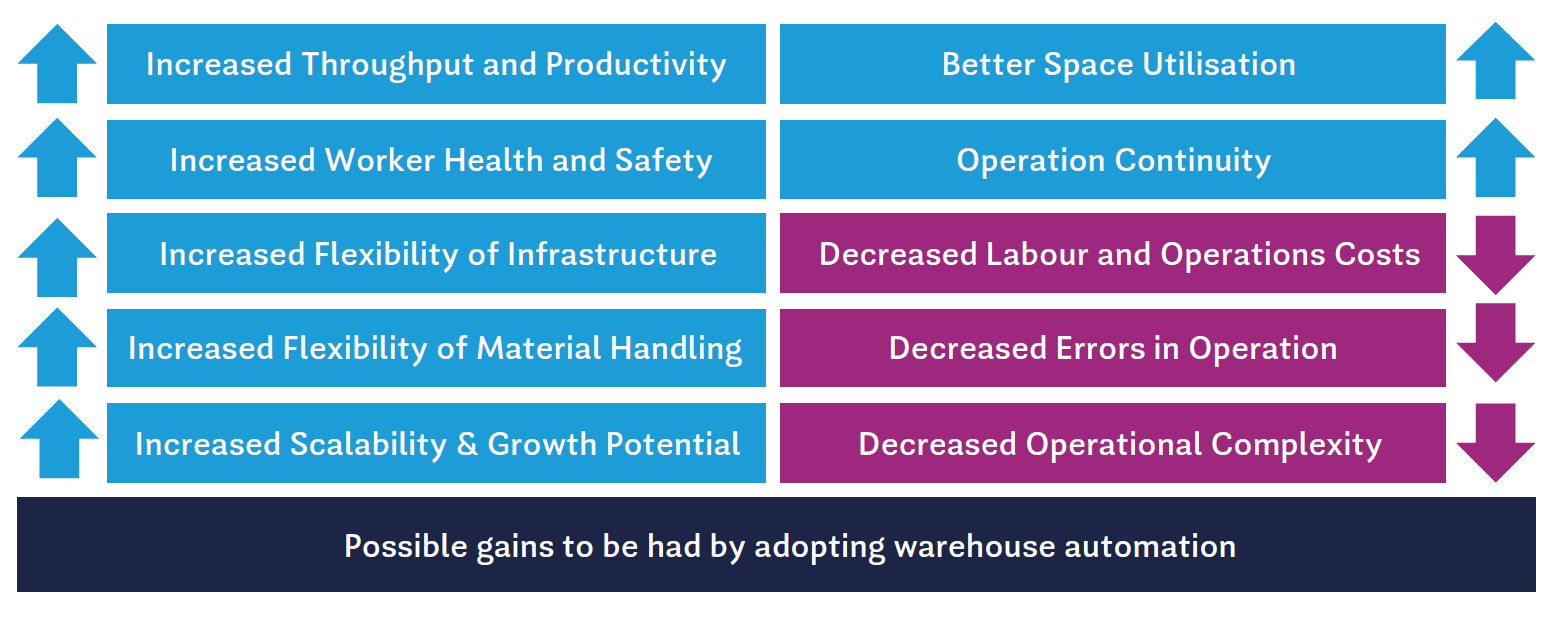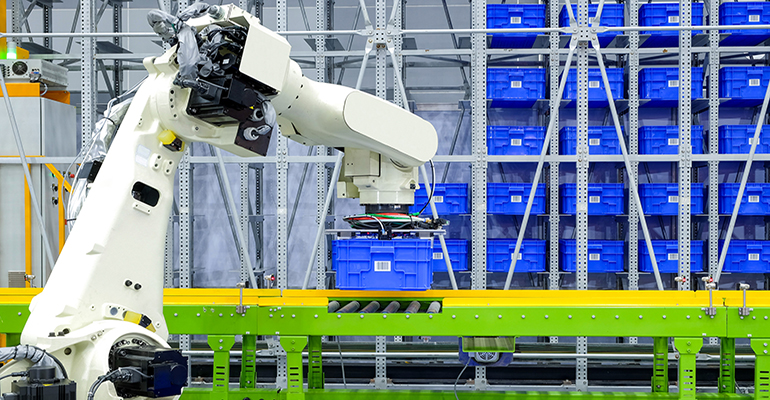Automation supports and changes warehouse activities so that they can be performed without or with minimum human assistance. It increases warehouse throughput by working 24/7, handling non-value-added tasks error-free, such as product movement. The pace of automation implementation across all areas of the supply chain, but especially in warehouses, has intensified through the COVID-19 pandemic and a shortage of warehouse staff in many countries. According to Logistics IQ and Statista, the global warehouse automation market size is expected to double from $15bn in 2020 to an estimated $30bn in 2026.
Warehouse automation is not only about physical robotic automation. It is also a combination of software and hardware to replace manual operations. Indeed, many automation solutions are triggered through the warehouse management system software and efficiently operate using artificial intelligence, data analytics, and the cloud.
Potential contributions of warehouse automation are shown in the figure below.

When futureproofing warehouse operations, managers need to be aware of current trends and technologies that can increase the overall performance of the warehouse, and they have to consider flexibility from multiple angles.
Having flexibility in infrastructure enables a system to accommodate changes in processes or layout, whilst flexibility of a chosen automation solution enables future alterations. For example, compared with automated guided vehicles, autonomous mobile robots provide higher flexibility in robot navigation and are more adaptable.
Lastly, flexibility in material handling enables the system to handle various shapes and sizes of stock-keeping units (SKUs). In futureproofing, managers also need to consider the compatibility of a chosen solution with other automation technologies. We will now provide examples of the areas and processes suitable for automation.
Truck (un)loading
These processes aim to increase the speed and accuracy of (un)loading a truck and avoid potential accidents resulting from completing the same task using manual labour. The two main trends in automating truck loading and unloading operations are using conveyors and autonomous forklifts. Even though conveyor solutions need considerable space to be dedicated to the operation, they increase the (un)loading speed by five-six times.
Since conveyors can carry many pallets simultaneously, autonomous forklifts are not as fast as conveyors. Yet, they are less expensive, far more flexible, require less space, and more adaptable to process alterations.
A novel way of unloading a non-palletised truck using robotic arms supported by computer vision is being tested for sorting packages arrival in a warehouse. The robot fits onto the back of a lorry and its arm has suction cups that picks up several boxes at a time and then feed them onto a conveyor belt. While a human worker can unload between 600 and 1,200 boxes an hour, this robot is expected to unload 1,500 boxes an hour.
Put-away and stocktaking
Products are received mostly on pallets, and a relatively novel method for automatic handling is offered by autonomous or laser-guided forklifts/reach trucks. They present a scalable solution that can be fitted to an existing racking setup.
Warehouse operations depend on accurate stock levels and full visibility of storage locations. Mobile robots can be used for scanning and counting upon receiving, determining handling requirements and put-away locations. Drones are then used to scan storage locations to perform stock counts and eliminate potential inventory discrepancies, removing the need for manual counts.
Order picking & replenishment
Since 50-60% of the total operating costs are attributable to picking operations in manually operated warehouses, picking automation attracts a high level of academic and practitioner interest. Mobile robots and various automated storage and retrieval systems (AS/RS) are implemented to eliminate any unproductive travelling time of human pickers.
Such solutions significantly increase pick rates and create room for further productivity growth while reducing space requirements and picking errors. Mobile robots visit the product locations (picking by themselves or operating alongside a human picker) or carry material handling units, such as shelves or pallets, to human pickers.
Novel AS/RS solutions, such as cube storage, can be retro-fitted to existing warehouse spaces and may be used for products with special handling requirements such as chilled items. These solutions are both flexible and scalable in line with the requirements of agile supply chains.
Sortation, packing, wrapping
Sortation could become a bottleneck in warehouse operations, especially in chaotic warehouse environments with tens of thousands of SKUs. Mobile robots are used for product or order (package) assortments to decrease the presence of relatively inflexibly structured conveyors.
Mobile robots take the products or packages from the source conveyor in one version and distribute them to sortation holes in the ground where each hole belongs to a different address. In the other version, mobile robots distribute these products or packages to various sortation conveyors where each conveyor route belongs to a different address.
In packing operation, many warehouses have been using finger scanners for years, ensuring picking accuracy while providing hands-free packing operation. Moreover, if outbound operations consist of pallets, we commonly see automatic wrapping machines which avoid losing worker time and wrap the pallet smoothly. Recently, mobile robot solutions feed pallets into or receive pallets from the wrapping machine to completely automate the wrapping operation.
Automation evaluation and selection
ABI Research forecasts that more than 50,000 warehouses (up from 4,000 warehouses in 2018) will use over 4 million mobile robots globally by 2025. As can be inferred from their applications and contribution to warehouse operations, various potential automation opportunities exist for autonomous mobile robots, barcode-guided robots, and human-collaborative robots (co-bots).
Warehouse decision-makers cannot risk falling behind in implementing these opportunities as they need to respond to agile and dynamic supply chain environments of tight deadlines, complex orders, and increasing demands. Such investments involve many trade-offs and focus areas, and decision-makers need to navigate the growing landscape of automation options and technology providers. Our expertise at Cranfield University is the structured evaluation of requirements, system selection, and implementation processes. Please feel free to reach out to discuss this further.
About the Authors
The contributors of this article are all affiliates of the School of Management at Cranfield University, within the Centre for Logistics, Procurement and Supply Chain Management. Alp Yildirim is a Researcher & PhD Student, Hendrik Reefke is a Senior Lecturer & Director of Full Time MSc, and Emel Aktas is a Prof Supply Chain Analytics.
This article was featured in the Logistics Report Automation edition. Click here to read the full report.


